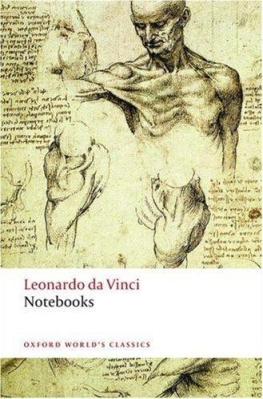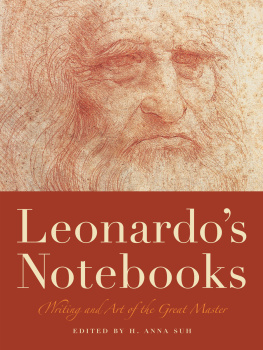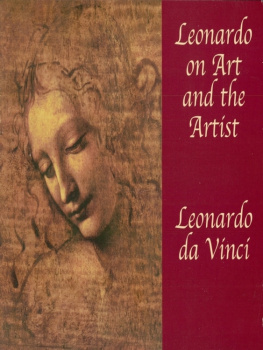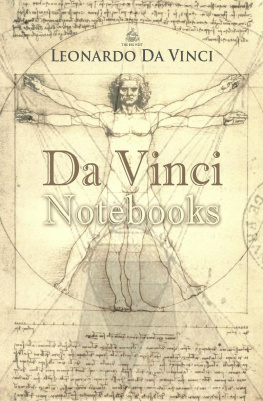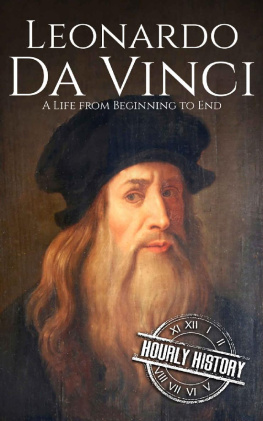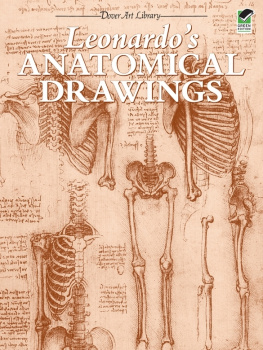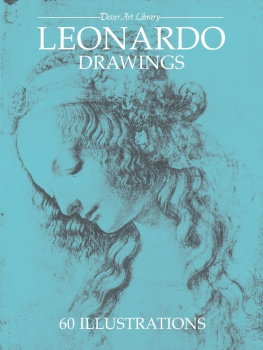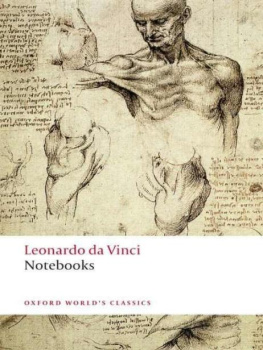Table of Contents
OXFORD WORLDS CLASSICS
NOTEBOOKS
LEONARDO DA VINCI was born in Tuscany in 1452, the illegitimate son of a Florentine notary. By the age of 20 he was in Florence where he became a pupil of Verrocchio. Around 1482 he left Florence for Milan, where he was to live for the next seventeen years. It was here that he undertook many of his scientific investigations and painted many of his greatest pictures, including The Last Supper . He returned to Florence in 1500 and stayed there for several years, during which time he painted the Mona Lisa . He returned to Milan where he stayed until 1513 when he went to Rome. His final years were spent in France, where he died in 1519. As well as a great artist, Leonardo was a deeply curious scientist and passionately interested in all branches of knowledge. His notebookscovered in sketches of flowers, clouds, birds, human anatomy, and designs for flying machines, fortifications, and waterwaystestify to his unquenchable curiosity and restless, acute intelligence.
IRMA A. RICHTER was the daughter of Jean Paul Richter, who first translated Leonardos writings in The Literary Works of Leonardo da Vinci.
THEREZA WELLS is a Research Fellow at the University of the Arts, London. She has worked on exhibitions at a number of museums in Britain and America, and was associate curator of the V&As exhibition, Leonardo da Vinci: Experience, Experiment, and Design. She is one of the founders, with Martin Kemp, of the Universal Leonardo project.
MARTIN KEMP is Professor of the History of Art at the University of Oxford. He is the author of Leonardo , and Leonardo da Vinci: The Marvellous Works of Nature and Man and the driving force behind the Universal Leonardo project.
OXFORD WORLDS CLASSICS
For over 100 years Oxford Worlds Classics have brought readers closer to the worlds great literature. Now with over 700 titlesfrom the 4,000-year-old myths of Mesopotamia to the twentieth centurys greatest novelsthe series makes available lesser-known as well as celebrated writing.
The pocket-sized hardbacks of the early years contained introductions by Virginia Woolf, T. S. Eliot, Graham Greene, and other literary figures which enriched the experience of reading. Today the series is recognized for its fine scholarship and reliability in texts that span world literature, drama and poetry, religion, philosophy and politics. Each edition includes perceptive commentary and essential background information to meet the changing needs of readers.


Great Clarendon Street, Oxford ox2 6DP
Oxford University Press is a department of the University of Oxford.
It furthers the Universitys objective of excellence in research, scholarship, and education by publishing worldwide in
Oxford New York
Auckland Cape Town Dar es Salaam Hong Kong Karachi
Kuala Lumpur Madrid Melbourne Mexico City Nairobi
New Delhi Shanghai Taipei Toronto
With offices in
Argentina Austria Brazil Chile Czech Republic France Greece
Guatemala Hungary Italy Japan Poland Portugal Singapore
South Korea Switzerland Thailand Turkey Ukraine Vietnam
Oxford is a registered trade mark of Oxford University Press
in the UK and in certain other countries
Published in the United States
by Oxford University Press Inc., New York
Selection Oxford University Press 1952, 2008
Introduction Thereza Wells 2008
Preface Martin Kemp 2008
The moral rights of the authors have been asserted
Database right Oxford University Press (maker)
First published 1952. First published in Oxford Worlds Classics 1980
New edition 2008
All rights reserved. No part of this publication may be reproduced, stored in a retrieval system, or transmitted, in any form or by any means, without the prior permission in writing of Oxford University Press, or as expressly permitted by law, or under terms agreed with the appropriate reprographics rights organization. Enquiries concerning reproduction outside the scope of the above should be sent to the Rights Department,
Oxford University Press, at the address above
You must not circulate this book in any other binding or cover and you must impose this same condition on any acquirer
British Library Cataloguing in Publication Data
Data available
Library of Congress Cataloging-in-Publication Data
Leonardo, da Vinci, 1452-1519
Notebooks / Leonardo da Vinci; selected by Irma A. Richter; edited with an introduction and notes by Thereza Wells; preface by Martin Kemp. p. cm.(Oxford worlds classics)
First published in 1952.
Includes bibliographical references and index.
ISBN 978-0-19-929902-7 (alk. paper)
1. Leonardo, da Vinci, 1452-1519Notebooks, sketchbooks, etc.
I. Richter, Irma A. (Irma Anne) II. Wells, Thereza. III. Leonardo, da Vinci,
1452-1519. Notebooks of Leonardo da Vinci. IV. Title.
ND623.L5A4 2008
709.2dc22
2007042346
Typeset by Cepha Imaging Private Ltd., Bangalore, India
Printed in Great Britain by
Clays Ltd., St Ives plc
ISBN 978-0-19-929902-7
1 3 5 7 9 10 8 6 4 2
PREFACE
MARTIN KEMP
LEONARDOs notebooks are amongst the most remarkable survivals in the history of human culture. There is nothing quite like them in art, science, and technology. The extraordinary fluency of his thought, unconstrained by disciplinary boundaries, and the brilliance of his graphic techniques are unrivalled. Probably about four-fifths of what he wrote has disappeared, but what remains is extraordinary in range and depth.
The existence of the notebooks and caches of drawings (inherited by his immediate heir, Francesco Melzi) was known in the sixteenth and seventeenth centuries, not least to artists like Poussin and Rubens. Melzis pious compilation of the Treatise on Painting , which contains many passages from manuscripts that are no longer traceable, was published in Italian and French in 1651. However, by the nineteenth century there was very little knowledge of the extent or contents of Leonardos manuscript legacy. Jean Paul Richter changed all that. His editions of Leonardo in English and German effectively revealed an unknown Leonardo.
We now take it for granted that the private notebooks or papers of great individuals are of huge value in providing insights into their minds. Although drawings had been treasured since the sixteenth century, this was not the case with notebooks. Some manuscript legacies survived, such as those of Sir Isaac Newton, but they were revered as memorials or souvenirs rather than because their contents were considered to be of major importance. Richter was a pioneer in the movement that was beginning to realize the value of private writings and sketches that speak of a great mind at work, however unresolved the results might be.
There can be few if any works of historical scholarship published in the late nineteenth century that remain key sources today. An art historian and dealer, Richter was a protg of Giovanni Morelli, the inaugurator of systematic connoisseurship. His Literary Works of Leonardo da Vinci (1883) is an extraordinary achievement. He trawled through Leonardos horribly illegible texts, mostly unpublished, making a telling selection and providing the reader with parallel transcriptions and translations. Both have stood up notably well, though the translations are very much of their period, with their somewhat Shakespearian tone.
Richters selection is weighted more towards the arts than the sciences and technologies, although his choice of non-artistic texts gives a good idea of the nature of his writing on other topics. In 1938 Edward MacCurdys The Notebooks of Leonardo da Vinci in two volumes served to redress the balance, and Richters daughter Irma sensibly took advantage of his translated anthology. However, Richters earlier compilation, not least with the excellent Commentary published by Carlo Pedretti, remains my most frequent port of first call when I begin to research some aspect of Leonardos writings.
Next page
